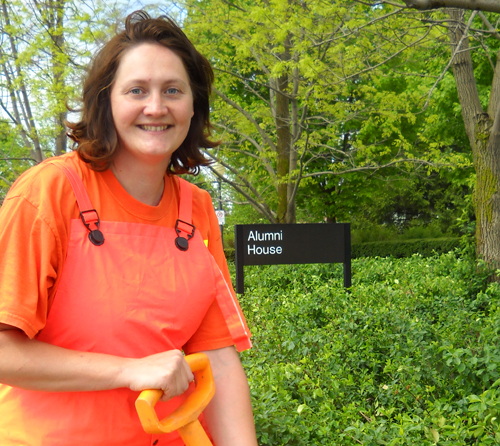
With the May long weekend upon us, it’s time to release your inner gardener. That goes for U of G grounds staff, too. Yes, they’ve been preparing campus gardens and green spaces for some time now. But at home, University gardeners will be just as busy this weekend and this summer as the rest of us.
We asked three U of G gardeners about this year’s plans and challenges in their own backyards and to share a few tips for other home gardeners. Here’s what they said.
Candice Welch
“A work in progress” is how Candice Welch describes her home garden in Brampton. A 2010 landscape technician graduate from Humber College, she joined Guelph this spring.
She tends the conservatory gardens near the University Centre. One day this week she was replacing some perennials in the four-seasons beds with planned “waves” of annuals, including Cleome, Canna and Amaranthus – all while looking out for newborns in a family of mallard ducks in the outdoor pond.
Her home garden requires lots of compost, including manure, to improve drainage and fertility. “Most of Brampton sits on very heavy clay,” says Welch, who plans a vegetable garden this summer. She’s also planning to build a small retaining wall and a short flight of steps, using uni-lock stone.
She grows perennials, annuals and shrubs in a mostly shady space. Those shade-lovers include impatiens, dusty miller, Japanese painted fern, Euonymus and barberry bush. This summer, she plans to plant Dutchman’s pipe (Aristolochia) to grow up her back fence. The fast-growing vine has an unusual-looking flower mostly hidden beneath leaves that she says are “half the size of dinner plates.”
She has tried bearded irises but without much luck. “They don’t do well in my yard. It’s probably too dry – they like it wet.” Her favourite plant is a hybrid tea rose whose shrub bears bright pink blooms. “I like pink. I’m looking into getting some pink spray paint to spray my tools.”
Look out for weeds this summer, she says. Check the Ontario government website for spray information, including rules about which plant species may be controlled and how. Under a ban on cosmetic pesticides since 2009, “noxious weeds are the only ones you can spray. The other ones need to be pulled.”
Dandelions? Canada thistles? “Keep a watchful eye on the weeds and, before they go to seed, pull them out.”
Brian Steed
Look out for invasive plants, especially ones that spread through underground stems called rhizomes, says Brian Steed. A grounds staffer since 1976, he tends gardens around the Ontario Veterinary College (OVC) and buildings that are home to departments of the Ontario Agricultural College.
Earlier gardeners favoured plants such as goutweed because their rhizomes allowed them to spread vigorously as ground cover. But invasive species threaten local biodiversity and can damage native species, according to the website of the Ontario Invasive Plant Council. Other information sources include the Canadian Food Inspection Agency; the Ontario Ministry of Agriculture, Food and Rural Affairs; the Ontario Ministry of Natural Resources; and the Ontario Federation of Anglers and Hunters.
Steed grows perennials, annuals, shrubs and vegetables in his part-sun, part-shade Guelph garden. He likes yellow and orange Fritillaria – spring-flowering bulbs in the lily family – and the spring-blooming viburnum shrub. “One of my absolute favourites is Viburnum juddii because of its fragrance. When the wind blows around the leaves, we get it when we enter the house.”
He plans to look into anemones (part of the buttercup family) for his garden, and also plans to move a flagstone patio this summer. A green spruce has been dripping its sap onto an umbrella. “I prefer not to cut the tree.”
This year’s gardening challenge? “Dryness. I think it’s going to be a dry summer.” He suggests using rain barrels to capture precipitation and a trickle irrigation system to deliver water directly to plants.
On campus, he and summer student Beth Ormond (second-year sociology) planted a garden this spring in front of the main OVC entrance to mark the college’s 150th anniversary. The bed features bronze-leaved fibrous red begonias and yellow-painted stones; he plans to paint a black border to complete the U of G colours.

Jackie Fosbery
Everything is new this spring for Jackie Fosbery, who looks after gardens on the east side of campus. She arrived at U of G last month after years spent in landscaping design and maintenance in Fergus and Elora.
She’s also just moved into a century-old stone house in Puslinch, south of Guelph, surrounded mostly by lawn. “It’s a clean palette,” she says. Well, there is that black walnut grove where little else will grow, but she plans to leave that space open as a play area for her two children.
She’s starting a 20- by 50-foot organic vegetable patch. “I’m going to try just about everything and see what works.” Also in the plans is an English-style perennial garden with such species as Perovskia (Russian sage), Echinacea, peonies and Gaura (beeblossom). She will mix in tropical plants that spend the winter indoors, including king palm, agave and croton.
Fosbery loves anything red, partly for herself and partly for the birds and beneficial insects attracted by the scarlet blooms. “I’ve always been partial to red. It makes me happy – anything bright. I’m not a pastel person.” Nor is she a fan of rhododendrons with their need for acidic soil. “I tend to like things that don’t need a ton of care.”
She looks for natural pest control, including companion planting (marigolds beside the vegetables) and adding pungent, insect-deterring herbs such as rosemary and basil. As for weeds, she says, “Make the pitchfork your friend.”
Rather than digging up the plant’s above-ground parts with a hoe, use a pitchfork to get at its underground roots. That also helps aerate the soil. She even uses her pitchfork on the lawn, adding grass seed to cover the bare patches. Don’t cut grass below three inches high. And “don’t expect to be absolutely 100-per-cent weed-free.”
She’s expecting a dry summer. Look for drought-tolerant plants such as sedum. New varieties such as the upright “Black Jack” and creeping “Voodoo” offer interesting foliage and textures. And consider grasses such as miscanthus that she’s eyeing for redoing several boulevards in campus parking lots.
